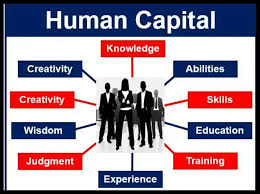Indian Economy – People As Resource- Notes For W.B.C.S. Examination.
ভারতীয় অর্থনীতি – সংস্থান হিসাবে মানুষ – WBCS পরীক্ষা।
Knowledge is the most significant and valuable property of a human being.Continue Reading Indian Economy – People As Resource- Notes For W.B.C.S. Examination.
Human resource has a great contribution to the Gross National Income.
Human resources development is the process of increasing the knowledge, the skills, and the capacities of all the people in a society. It is the accumulation of human capital.
- Human capital is more superior to other types of resources (such as land and other natural resources), as human capital has the capability to exploit these resources and use them for other developmental purposes.
- Economists and experts of other fields have advocated that education should be made accessible to every stratum of the society. Education is indispensable for overall national growth.
Features of Human Capital
- Transformation of a child into a successful educated man/woman after educational attainment (for example, doctor, engineer, teacher, government official, business man, etc.) facilitates the development of the human capital.
- Human capital is the sole source of overall development of the nation; therefore, investment in a child’s education, health, and other activities related to his/her growth is equivalent to the capital formation.
- Health expenditure includes preventive medicine (e.g. vaccination), curative medicine (medicines given during the illness), and social medicine (spreading the health literacy).
- Providing training either in public sector or private sector is also a kind of investment that produces knowledgeable and expert employees.
- Expenditure on human migration and acquiring information about the market is also a source of human capital formation.
- The contribution of a skilled and highly educated person is much more valuable than that of an unskilled labourer.
- The seventh five-year plan has emphasized on the need for human capital formation. It stated that
Human resources development (read human capital) has essentially to be assigned a key role in any development strategy, especially in a country with huge population
. - Though the two terms human capital and human development sound similar, there is a basic difference between them.
- Education and health are the major assets of human capital that enhance the labour productivity.
- On the other hand, human development considers education and health as an integral part of human well-being.
- Human Capital considers human beings as a means to an end. So, if an educated person with good health does not increase productivity, then the investment made on goes futile.
- The expenditure on education is measured on the basis of the percentage of total expenditure (by the government) and the percentage of Gross Domestic Product (GDP).
- In 1998, the Government of India appointed Tapas Majumdar Committeeto estimate the expenditure in education sector.
- The Right to Education Act of 2009, makes education a fundamental right for all children aged between 6 and 14.
- The percentage of expenditure on education sector has also been increased in comparison to previous decades.
- Various loan schemes have been made available for higher studies (in home country and also other countries).
- Moreover, with consistent efforts by the Indian Government, the literacy rate of India is increasing at an appreciable rate.
- Besides, the gap between male and female literacy rate has progressively narrowed.
Success Rate of Education in India
The following table illustrates the literacy growth rate −
| Numbers | Details | 1990 | 2000 | 2008-12 |
|---|---|---|---|---|
| 1 | Adult Literacy Rate (Age group 15+)
Male Female |
61.9 37.9 |
68.4 45.4 |
76.7 67.6 |
| 2 | Youth literacy rate (Between 15 & 24)
Male 88 Female 54.2 64.8 74 |
76.6 54.2 |
79.7 64.8 |
88 74 |
| 3 | Primary completion rate
Male Female |
78 61 |
85 69 |
96.6 96.3 |
Education and Life Expectancy Development Rate
The following table illustrates the life expectancy growth rate −
| Details | 1951 | 1981 | 1991 | 2001 | 2012 | |
|---|---|---|---|---|---|---|
| Per Capita Income | 5,708 | 8,594 | 11,535 | 16,172 | 38,037 | |
| Literacy Rate (in %) | 16.67 | 43.57 | 52.21 | 65.20 | 74 | |
| Life Expectancy at Birth (In Years) | Male
Female |
37.2
36.2 |
54.1
54.7 |
59.7
60.9 |
63.9
66.9 |
64.7
67.7 |
| Crude Death Rate (per 1,000/) | 25.1 | 12.5 | 9.8 | 8.1 | 7 | |
| Infant Mortality Rate | 146 | 110 | 80 | 63 | 42 | |
Our own publications are available at our webstore (click here).
For Guidance of WBCS (Exe.) Etc. Preliminary , Main Exam and Interview, Study Mat, Mock Test, Guided by WBCS Gr A Officers , Online and Classroom, Call 9674493673, or mail us at – mailus@wbcsmadeeasy.in
Visit our you tube channel WBCSMadeEasy™ You tube Channel
Please subscribe here to get all future updates on this post/page/category/website



 Toll Free 1800 572 9282
Toll Free 1800 572 9282  mailus@wbcsmadeeasy.in
mailus@wbcsmadeeasy.in


















































































































